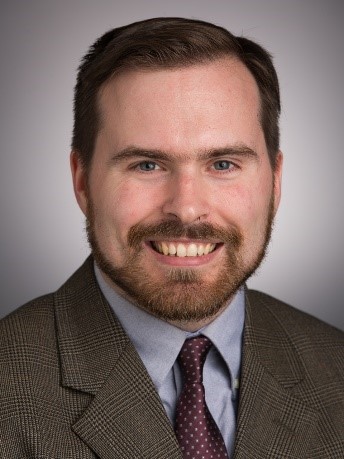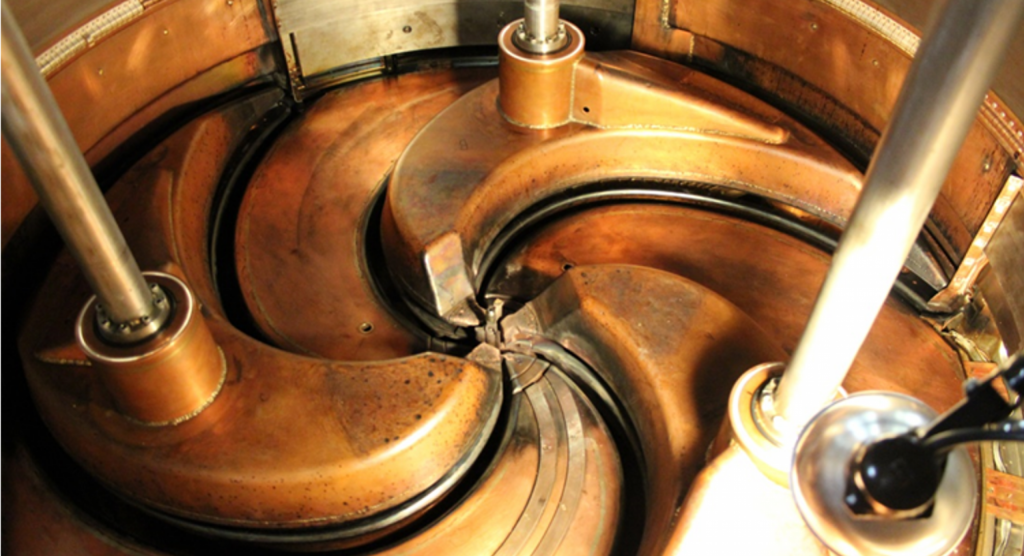The cyclotron has trained hundreds of graduate students over many decades. Here are the biographies of a few of them.
Dr. James L. Drachenberg

Dr. Drachenberg received his Ph.D. in Physics from Texas A&M in 2012. Following his degree, he spent periods as a Post-Doctoral Research Associate at Valparaiso University and as an Assistant Professor at Lamar University, before joining Abilene Christian University, where he is now Professor of Physics. Dr. Drachenberg’s research explores the partonic structure of the proton spin as a member of the STAR Collaboration. The STAR Collaboration comprises over 600 scientists and engineers from over 60 institutions in the US and a dozen other countries that operate the Solenoidal Tracker at RHIC (STAR) detector at the Brookhaven National Laboratory Relativistic Heavy Ion Collider (RHIC), analyze the data that it produces, and disseminate the results through talks and publications. Dr. Drachenberg has held several leadership roles within the STAR Collaboration, notably including co-Convener of the Spin Physics Working Group (2014-17) and Deputy Spokesperson (2017-20). His current research efforts focus on characterizing the three-dimensional momentum structure of the quarks within the proton.
Drs. Robert W. & Marianne E. Hamm
For the past 40 years, Robert has been active in the development of particle accelerators for physics research and commercial applications, including electrostatic accelerators, linear accelerators (linacs) and cyclotrons. He and his wife recently started R&M Technical Enterprises, Inc., doing consulting work in the accelerator field based on these many years of experience. For 22 years, he was the President and CEO of AccSys Technology, Inc., a successful company devoted to the development and manufacturing of ion linear accelerators for medical, research and industrial applications. The company was bought by Hitachi Ltd. in 2007. Prior to co-founding AccSys in 1985, he was Manager of Research in the Radiation Division of Varian Associates, with primary responsibility for the development of new medical and industrial electron linacs. Robert was Vice President of R&D at The Cyclotron Corporation from 1981 to 1983, with responsibility for product development of commercial compact cyclotrons, and was acting head of the manufacturing group in 1983. Prior to that, he was a research staff physicist from 1977 to 1981 at the Los Alamos National Laboratory (LANL) in the Accelerator Technology Division where he participated in the National Cancer Institute program to develop a linac for cancer therapy and was a key member of the Radio Frequency Quadrupole (RFQ) proof-of-principle demonstration effort. Robert has over 80 publications in the scientific and engineering literature and has given numerous talks and colloquia worldwide. He has a BS in physics from the University of Southwestern Louisiana, an MS in physics from Florida State University and a PhD in accelerator physics from Texas A&M University. He has served on the Committee for Application in Physics within the American Physical Society and has worked as a visiting scientist in Dubna (JINR), Geneva (CERN) and Canada (Chalk River), and has worked in Saudi Arabia on a mission for the International Atomic Energy Agency.
Marianne attended Annapolis High School and was in the Navy’s cooperative work-college program while attending Virginia Polytechnic Institute, where she majored in physics and graduated with honors in 1968. She received a fellowship at Florida State University to pursue graduate studies in experimental nuclear physics. While at Florida State she met her future husband, Robert, also a physics graduate student. After getting Masters Degrees from Florida State, they went on to pursue their PhDs together at Texas A&M University where they broke new ground as the first married couple in the physics graduate studies program. In addition to sharing the graduate school experience, they shared the responsibility of raising an infant son. Marianne also served as President of Graduate Student Council and as a graduate student advisor to the Vice President of Student Affairs and Dean of the Graduate School. After receiving her Ph.D. in 1976 from Texas A&M (with honors and a Distinguished Graduate Student award), Marianne became a post-doctoral fellow at the Los Alamos National Laboratory doing medium energy nuclear physics research. She went on to serve as a staff physicist involved in plasma physics research and applied nuclear technology. She left Los Alamos in 1981 with Robert when he accepted a position as Vice-President of R&D at The Cyclotron Corporation in Berkeley, California. Marianne started a consulting firm specializing in computer control and data acquisition software for scientific research and medical applications. Then in 1985 she co-founded AccSys Technology with Robert and two colleagues from Los Alamos. As Executive VP and COO of AccSys Marianne was head of all business operations and was also a member of the Board of Directors. In addition to her corporate duties as COO of AccSys, Marianne worked in a number of organizations to assist small business development:
- Founding board member in 1991, 1995 President, and 1996 Chairwoman of Academy of Technology Entrepreneurs and Innovators
- Testified in Congressional hearings for 1993 SBIR program renewal legislation.
Elected delegate to 1995 White House Conference on Small Business; Region IX Technology Issue Implementation Chair - Served on American Electronics Association Board of Directors from 1997 to 2000.
Over the past two decades, Marianne has given numerous invited talks at professional meetings, secondary schools, and universities on a variety of topics, including promoting the role of women in science and engineering and alternative careers in business for scientists. She has also been invited by several groups to recount her company’s experiences with various Federal technology transfer, technology partnership and defense reinvestment initiatives.
Dr. Elizabeth Bell
Dr. Elizabeth Bell received a B. S. in Chemistry from The University of Texas at San Antonio in 1996. She later joined the research group of Sherry Yennello at the Cyclotron Institute at Texas A&M University and earned a Ph. D. in Nuclear Chemistry in May 2005. After receiving her Ph. D., Dr. Bell took a postdoctoral position at Los Alamos National Laboratory where she for the X-2 division in collaboration with the C-INC division. At present she is an instructor at Blinn College in Bryan, TX, teaching chemistry and physics.
Dr. John C. (Kris) Hagel
Dr. Kris Hagel enrolled in Texas A&M University in Sept. 1977, graduated with a B.S. in May 1981, and with a Ph.D. in Dec. 1986. His doctoral dissertation subject was a study of the properties of hot nuclei. After completion of the Ph.D., Dr. Hagel spent one year as a Post-Doc in France at GANIL, the French National Accelerator where he participated in experiments and analysis of experiments dealing with the subject of multifragmentation. Dr. Hagel then spent one year in Germany working with a group that concentrated on experiments with gamma rays and their application in the analysis of hot nuclei. After that, he then returned to the Cyclotron Institute where he continues to be involved in research regarding reaction dynamics of hot nuclei. In addition, for the last ten years, Dr. Hagel and his group have been involved in the planning, construction, execution and analysis of a relativistic heavy ion experiment at Brookhaven National Laboratory in New York.
Dr. Jehanne Gillo
Dr. Jehanne Gillo has worked at the Department of Energy since February 2000. Dr. Gillo first joined the Office of Science’s Office of High Energy and Nuclear Physics, Division of Nuclear Physics at the U.S. Department of Energy as Program Manager for Facilities & Instrumentation. Dr. Gillo took her present position as the Director of the Facilities and Project Management Division, Office of Nuclear Physics, Department of Energy in October 2005, where she is responsible for the operations of the nuclear physics scientific user facilities, large construction projects, fabrication of scientific instrumentation, accelerator research and development, and the nuclear physics SBIR/STTR program. Since 2008, she also assumed responsibility as the deputy to the Associate Director of the Office of Nuclear Physics. In addition, she is Director of the DOE Isotope Program since 2009. She received the Secretary of Energy Excellence Award in October 2012 for her management of the DOE Isotope Program. Dr. Gillo serves on several White House committees and Interagency Groups, including as Chair of the He-3 Interagency Working Group that reports to the White House National Security Staff. She received the 2016 Achievement Award from the Secretary of the Department of Energy for her efforts as part of the Joint Comprehensive Plan of Action (JCPOA) Support Team. Jehanne Gillo was awarded the 2016 Presidential Rank of Meritorious Executive Award for her accomplishments as the Director of the Nuclear Physics Facilities and Project Management Division.
Dr. Gillo obtained her Bachelor of Science Degree from Juniata College in 1985. As a graduate student at Texas A&M, Dr. Gillo majored in Nuclear Chemistry with an emphasis in relativistic heavy ion physics research and received her Ph.D. Degree in 1990. She held the position of Physicist at Los Alamos National Laboratory (LANL) from 1990-2000. She has worked as a Guest Scientist at the Niels Bohr Institute in Denmark, and has conducted nuclear physics experiments at CERN, RHIC, LANL, and Texas A&M University.
Heather Baxter
Heather Baxter has over 25 years of professional experience including working as the lead chemist and radiation protection scientist for Shearon Harris Nuclear Power Plant and principal scientist for Arcadis. Through her roles as scientist in chemistry and radiation protection and manager of the radiological environmental program, she has direct experience measuring, controlling, and removing radioactivity in the environment and plant fluid systems. As the site’s subject matter expert on radiochemical and isotopic analysis, she directed the site’s personnel radiochemical spectroscopy analysis and supported the calibration and verification of Count Room spectroscopy instruments. She used this data to model the production and decay of nuclear by-products to predict the concentration of each species in the effluent stream and to calculate the dose to workers and members of the public. Ms. Baxter has a master’s degree in Nuclear Chemistry from Texas A&M University. She served as the Nuclear Energy Institute – Radiological Effluent and Environment steering committee chairperson from 2016-2019. She was the recipient of the United States Department of Energy Patricia Robert Harris Fellowship, Duke Energy Ruth B Shaw Award, and Nuclear Energy Institute Top Industry Performance Finalist

